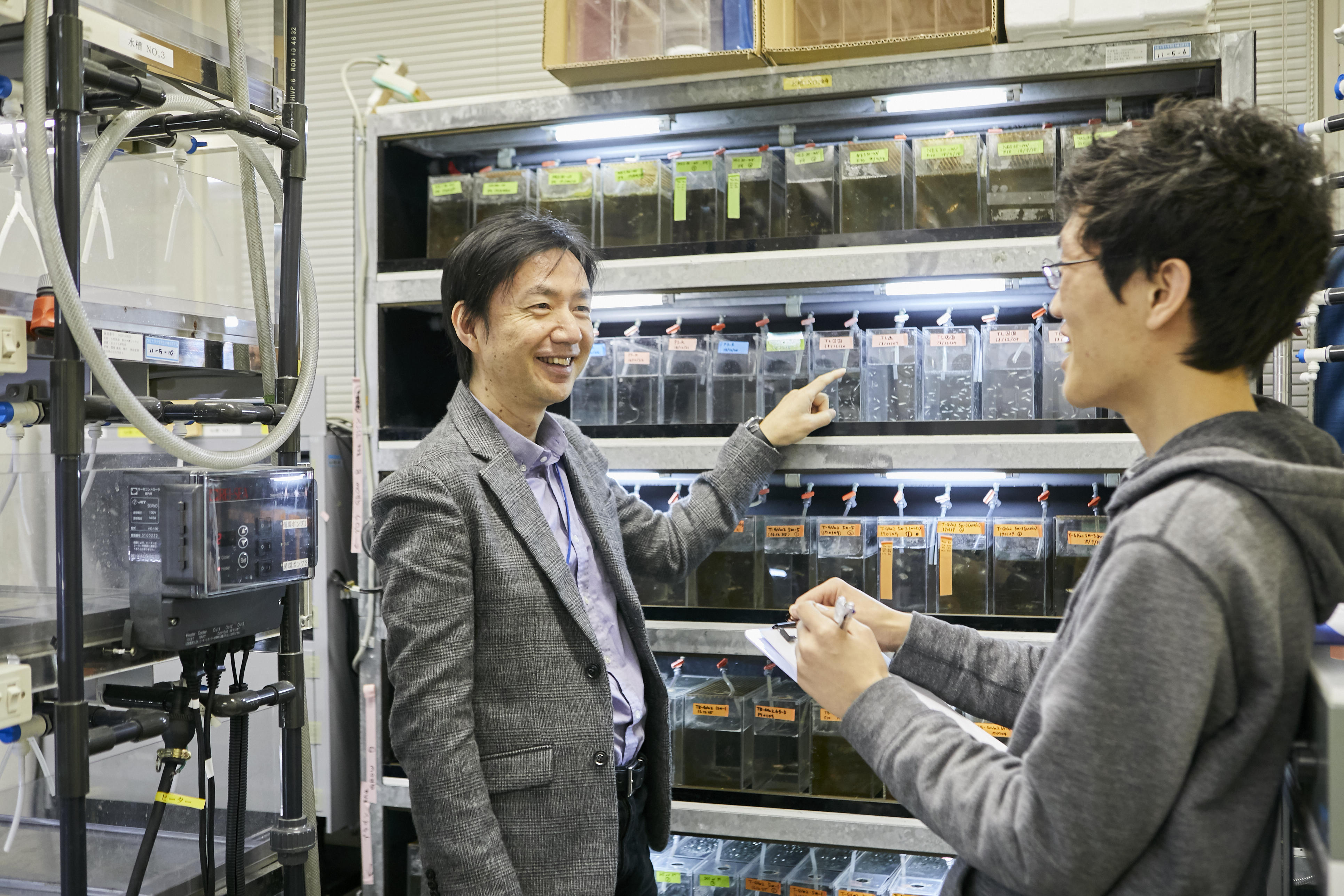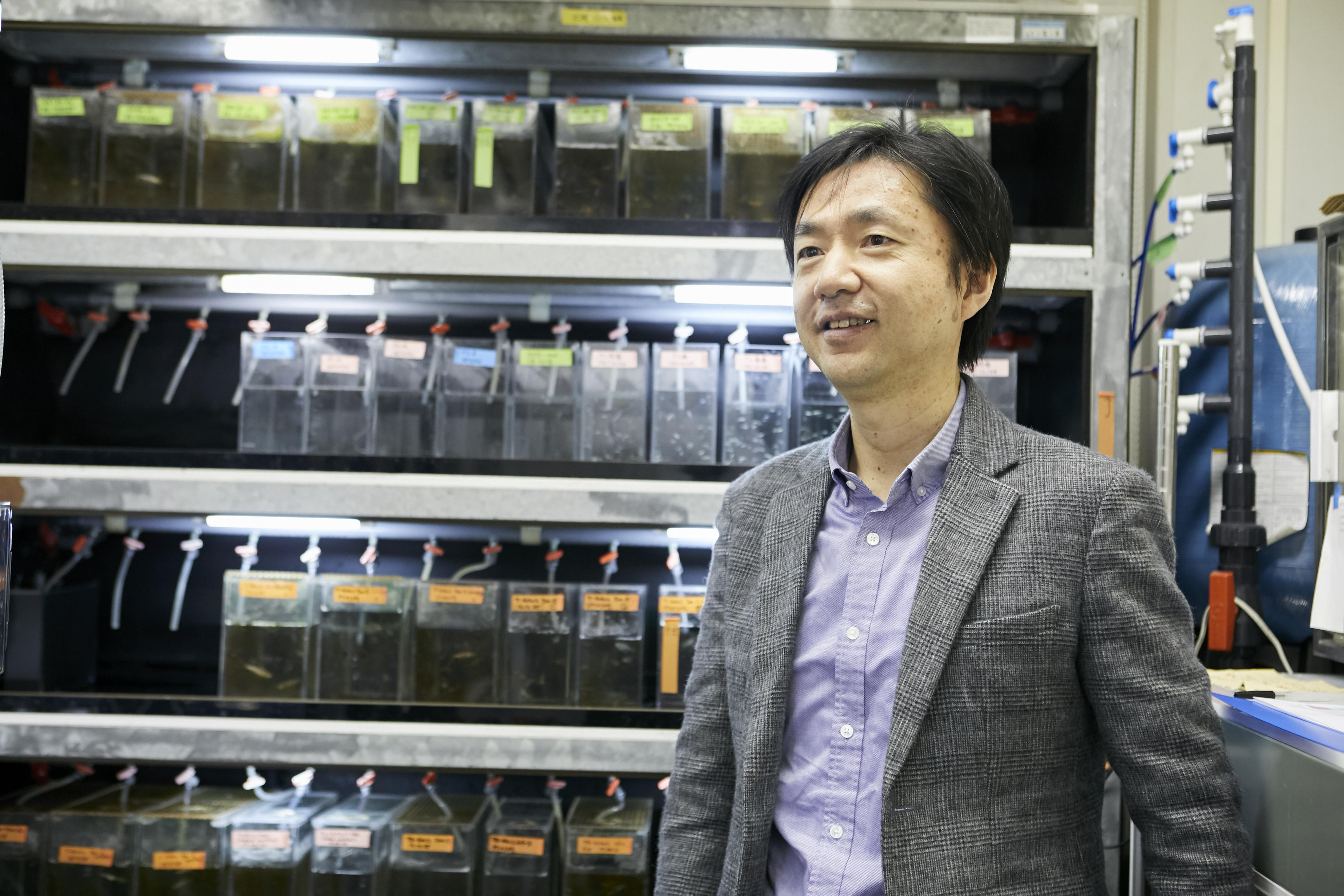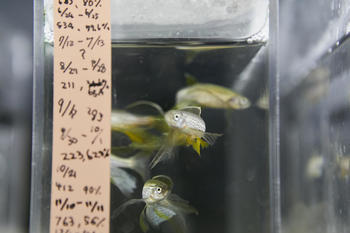- TOP
- Cutting-edge Research and Social Contribution
- Cutting-edge Research
- Revealing the mechanism of development in humans and animals

Revealing the mechanism of development in humans and animals

Exploring gene usage in zebrafish
Our body is a vast complex of cells. Every animal can be traced back to a single cell, a fertilized egg. From that tiny beginning, through complicated processes, a body with various tissues and organs is created. That entire process is called development.
In embryos, organisms at the early stages of development, the nature of cells changes rapidly. As the shape and function of those cells change, organized tissues and organs are gradually formed. The development of embryos proceeds according to the genetic information in genome DNA. Professor Kamachi has been conducting research on the mechanism of how that genetic information is read, through his studies of zebrafish, a species of tropical fish.

Prof. Kamachi says, "The developmental process produces a wide variety of cells including brain, eye, heart and skin cells, where the combinations of genes used differs depending on the cell type. It is known that there are about 22,000 genes in the human genome. I became interested in the mechanism of the differential usage of such huge numbers of genes, and since then I have been conducting research in this field."
Zebrafish are small fish, similar in size to medaka (killifish). They are used as model vertebrates in various studies in the life science field because they reach sexual maturity in about 3 months and one pair of zebrafish can produce large numbers of eggs, 100 to 200 eggs, in a single mating.
Prof. Kamachi explains, " Zebrafish have many attributes that make them suitable for biological research. They are small in size, easy to breed and prolific, and their embryos are very easy to observe owing to their transparency. If we used mice, since the development of embryos is done inside the mother's belly, the same as in human beings, the embryos would be difficult to observe."
Can we really gain an understanding of the process of human development by observing fish? Prof. Kamachi replies, "The developmental process of vertebrate embryos and the functions of tissues and organs in species from fish to humans are very similar. So, what we learn about fish does apply to humans in most cases. That is, human genetic functions and biological causes of various diseases can be investigated using zebrafish as a model organism."
It is also known that abnormalities in embryonic developmental processes are responsible for various diseases in humans. Research using zebrafish could lead to an understanding of the pathogenesis of such diseases.
Discovering the role of the Sox transcription factor family in the embryonic developmental process
Genetic information written in DNA is copied to RNA, and proteins are produced based on that copied information. The proteins that control the former task, called transcription factors, are very important for the creation of a specific state of cells. They play an on-off switch-like role by regulating the first step of gene expression called transscription. However, there are still many mysteries related to the mechanism of changing the state of cells.
Among the thousands of transcription factors, Prof. Kamachi has focused on a group called Sox. The Sox transcription factor family has various functions; for example, the famous protein called Sox2 is essential to create iPS cells, induced pluripotent stem cells that can form the various tissues of the body.
"A while ago I was studying chickens as a model, investigating how the lens of the eye is made. At that time, I discovered that Sox was the transcription factor that turned on the switch to make cells become the crystalline lens of the eye. I understood that Sox worked as a switch. Then I wondered what other roles Sox might play, so in my research I have been focusing on the elucidation of those roles."
Sox is strongly involved in the development of the crystalline lens. This discovery was a turning point in Prof. Kamachi's research life. In order to discover the sort of functions that Sox plays at the developmental stage of embryos, he has been conducting experiments using a method called knockdown, which suppresses Sox functions.
"I have found that when we knock down the four genes of the Sox family and create zebrafish embryos without them, abnormalities occur in the development of the central nervous system."
Transcription factors act on each specific-gene sets, which creates something like an electronic circuit called gene regulatory network. By decoding those circuits, Prof. Kamachi is investigating a mechanism for more accurate cellular differentiation.
Influence of environmental factors on embryo development
The development of embryos through complex processes basically follows the instructions of genes. However, it has been found that embryo development is also greatly affected by the environment in which the embryo is placed. In the case of humans, it is known that chemical substances such as medicines taken by the pregnant mother affect the development of the fetus, but the mechanism by which such influence occurs has not been well explained.
Several years ago Prof. Kamachi started a new study focusing on the relationship between environmental factors and embryo development, in particular the relationship with gene expression.
"For example, we know that human embryos are very sensitive to alcohol, but we still don't understand the mechanism clearly. It has been found that even low concentrations of alcohol have some effect on the fetus. It is said that about 1% of babies in the U.S. are born under the influence of alcohol. However, in Japan, such statistics have not even been collected yet, and many problems may have been overlooked."
How does alcohol affect embryonic development? Using zebrafish, Prof. Kamachi is investigating the process by which alcohol affects gene expression and causes damage.
Moreover, there is currently a debate about whether an influence received when the fetus is in the mother's body remains undiminished even after the child is fully grown. Recently, it was found that there are some cases where a condition diagnosed as developmental disorder or autism in a child is in fact the result of exposure to alcohol during the fetal stage.
"There is a possibility that the mechanism by which the effects of alcohol and chemicals last for a long time may be related to epigenetics, a cellular memory mechanism in which gene expression becomes fixed and is inherited. The key of epigenetics is thought to be a protein called histone. Through research using zebrafish, we found that there is a possibility that histone modifications may be altered by alcohol. With this insight as a key, I would like to pursue further elucidation," says Prof. Kamachi.
The negative effects of chemicals on humans and animals are immeasurable, for example fetal alcohol spectrum disorder, caused by alcohol intake by the mother during pregnancy. Pursuing this little understood area, Prof. Kamachi hopes to mitigate the ill effects of chemicals on humans and animals as much as possible. He says that he is strongly attracted to this field because so many phenomena are not yet understood.
"There are still so many things that we do not know about living things. As soon as a new discovery is made, another question arises--it's endlessly interesting."
